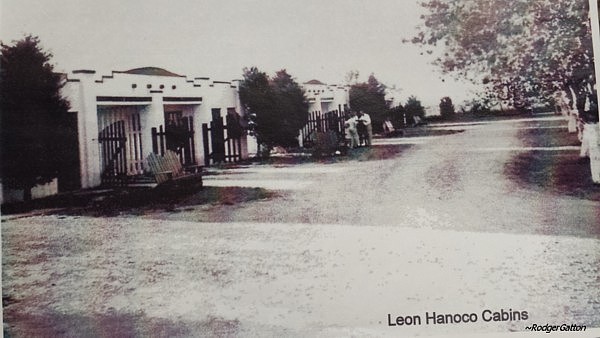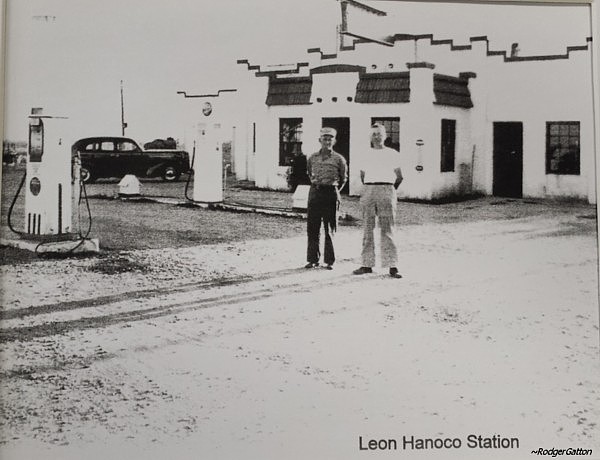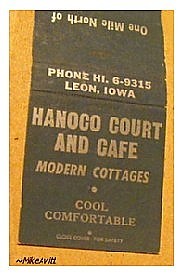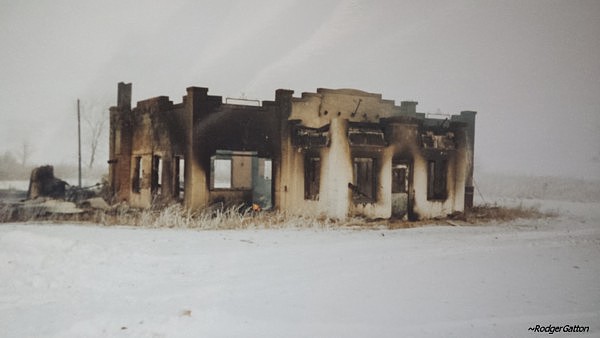

Memories Of Hanocoby Rodger Gattonappeared in the Leon Journal-Reporter, December 28, 2009 |
 |
| There once was a magical place called Hanoco Court, located
about a mile north of Leon, Iowa. Now reduced to just three storage
buildings, at least one falling in, Hanoco once consisted of a filling
station/truck stop, a cafe, a cabin court, a roller rink, and a welding
supply business. My father was hired in 1949 by Burbank Halstead, the
owner, to run some routes selling and delivering welding supplies. At
first he worked just a few days a week, then began filling in at the
station when he wasn't on the road. Eventually he built up the welding
supply business until it was almost more than a full-time job. I used to help him with it, as did all the members of our family at one time or another in one way or another. I would ride with him on the truck, record the numbers of the oxygen and acetylene cylinders in a steno pad, so my mother could write them in a record book and keep track of what customer had what cylinders. My brother and I, maybe at separate times, would help load and unload the truck. When I was about 12 or 13 years old, Burbank hired me to mow the grass around the house and cottages. Soon I was also working at the gas station on weekends. No one who worked at the station ever wore uniforms, but in the summer I would usually be attired in shorts, a cut-off sweatshirt, and I walked shoeless over the limestone rocks of the drive, to wait on customers. If OSHA had existed in those days, I'm sure they would have frowned on my lack of shoes, but customers were always amazed that I could walk around over the fairly sharp-edged rocks and show no sign of pain. Of course, in the winter I wore shoes and more clothing, and still froze my butt off, filling trucks that required 50-100 gallons of fuel. Boy could the wind whip across that flat ground! In the summer we would see little whirlwinds come gliding across the parking lot. In winter the drifts of snow would get piled high. It's a wonder I do not have some kind of lung disease from working at Hanoco. In cold weather, the other station attendants and customers would sit in the small office and smoke and smoke and smoke. I've inhaled my share of second-hand unfiltered Camels and King Edward cigar smoke. I also liked the smell of gasoline. Though I never just put my nose down to the source to take a big whiff, I made no effort to move if the breeze brought the fumes in my direction. |
 |
| Part of the job of the station attendant was to rent the
cabins (or cottages as they were sometimes called). They rented anywhere
from $4 per night, for a trucker, to $8 a night for a family. Seems like
they should have been more, but then at that time, gasoline was about 30
cents a gallon. For a good number of years my mother cleaned and did the
laundry for the cabins. In later years, after I-35 took away all the
tourist traffic, I converted most of the cottages into monthly rentals. I remember looking through a window into the skating rink when I was just a little kid. I don't know why I never tried skating, but I didn't. I remember seeing Burbank Halstead skating around the rink and he could all of a sudden turn around and be skating backwards. I thought that was so cool. I did go skating a few times as a teenager, but not at Hanoco. The rink was closed by then and became a big storage room. Previous to being a skating rink, it had been a dance hall, back in the '30s and '40s. At that time, there was a long room with booths in it along the back side of the rink and I think people would bring their own liquor and have drinks there, in between dances. When my brother and I poured a new concrete floor back in that room, we found down inside the walls, a huge number of 7-up and Cheer-Up (bottled in Osceola) bottles.  Supposedly
some fairly famous bands played at Hanoco, but I have no direct proof.
One of the names that's mentioned is Lawrence Welk, and he was from the
midwest, so it could be true. I'd love to find a showbill for a Hanoco
dance. Supposedly
some fairly famous bands played at Hanoco, but I have no direct proof.
One of the names that's mentioned is Lawrence Welk, and he was from the
midwest, so it could be true. I'd love to find a showbill for a Hanoco
dance.Orignally the house next to the cafe, and the cabins, had no indoor plumbing. There was a men's and a ladies' room on the north side of the main building, and each had a little shower room behind it. That would seem to be where the guests in the cottages, and the people who lived in the house went, when they needed a bathroom. Six cabins were eventually joined together to make three larger units and at that time I believe bathrooms were installed in each unit. The cafe was always a bustling place. In addition to the truckers and the travelers, folks from town would come out for lunch, or maybe just for coffee. After events such as ball games, the cafe would also fill up. Sunday dinners were a favorite time for diners. I liked the hamburgers and french fries, the fried shrimp, and the pies, especially coconut cream. At that time, a meal could be had for a buck or less, pop was a dime, and pie was about a quarter. My favorite part of the cafe was the Seeburg jukebox in the corner. I was always fascinated at how it played the records in a vertical position. The only time the cafe closed was from midnight to 6 a. m. Sunday morning. At midnight, our family would go into the cafe, move all the furniture, strip the old wax off the floor, and give it a nice new shiny coat. My dad saved some of the money we made from that job ($10 a night for the whole crew), and bought a portable typewriter for me when I went to college. Probably the very best part about Hanoco was the family atmosphere. After working awhile with the others in the station and cafe, they became like an extension of our family. When Burbank Halstead died suddenly of a heart attack, it was like my favorite uncle had passed away. Some couples worked there, the man in the station and the wife in the cafe. Most of those I worked with are gone now - Johnny Baker, Bunk Roland, Jim Clark, Gerald Moomey, Lewis Bunch, Maurice Redman, Ellen McClain, Stella Collins, Kathy Decker, Pansy Leib. Maurice Redman died of lung cancer or emphysema. He was one who supplied much of my second-hand smoke. Bunk Roland stopped smoking those unfiltered Camels and lived a long and healthier life. Guy and Luella Hess still live in Leon and are among the last of the older Hanoco employees. My brother and I would often imitate the way Maurice Redman would sit down on the chair. He'd start to squat, place one hand on each knee, lower himself very slowly, then when he got about 6 or 8 inches off the seat, would just drop the rest of the way. |
 |
| Jim Clark once told us a story about how he'd stopped at the
Dairy Queen for an ice cream cone on the way to work. He ordered a
nickel cone, and the girl at the window told him they no longer had
nickel cones. The cones were now 15 cents. So he ordered a 15 cent cone
and when he got it, he told the girl he believed she'd lied to him. They
still had nickel cones, they just charge 15 cents for them. Stella Collins would stop at the phone in the station each day on her way to work in the cafe. I don't think she had a phone at home, because she always called her aunt from Hanoco. This was the first part of every conversation: "Hello, how are you." Pause while her aunt answered and inquired about her health. "Oh, able to get around." This same beginning to her conversation occurred day after day without the slightest change. That's why it's so indelibly imprinted into my brain. Stella was, in my opinion, just barely able to get around. She shuffled around in slippers and had always mashed the backs of them down. I felt sorry for her and wanted at times to go and help her with the big pans of potatoes she carried from the storeroom to the kitchen, but I don't think I ever did. The people who worked there were interesting but so were many of the customers and some who stopped in for other reasons. Some who come to mind are Loren Woodard, who would always say when entering "Well, what do you think about 'er, Louie?' whenever Lewis Bunch was on duty. Our night marshal from town, Walter Stover, would always stop just inside the door in the winter time, take out his handkerchief, and give one sharp blow of his nose before going on into the cafe. Cappy Ricks was a guy who came around to fix the neon signs. His car was very shabby. Leo Hibbert had removed the front passenger seat of his car, and his wife sat in the back. I guess she must have had really long legs or needed to keep them stretched straight out. He was always talking about how "rough and tough" things were. "In the rough" was a phrase he used a lot. I don't think he knew a lot of words. As the years passed, Hanoco evolved. It had to as I-35 replaced Highway 69 as the main route from Des Moines to Kansas City. The cottages were shut down, the cafe hours reduced, then it too closed. The station was no longer open 24 hours. My brother added a small engine repair shop and lawn mower and chain saw sales to the business. The station stayed open, but mostly to service welding customers who might want to pick up their own supplies. |
 |
| If you stop at Hanoco and look past the weeds, you can see the
cement slabs where the main buildings once stood. You can even see a few
remaining floor tile in the part that was the cafe, those same ones my
family polished. You can see the places where the kitchen, the
restrooms, and the skating rink once stood. The only part of the
original place that was saved was the brick fireplace that once stood in
front of the cottages. I got permission from the new owners to take it
home with me. I had used it many times to cook hamburgers and hash
browns when I lived in a mobile home on the property. Now I use it in my
back yard to cook hamburgers and hash browns. With a little help from a man with a wrecker to move the slab and the first few courses of bricks, and from my brother to help me mortar it all back together again, the fireplace started a new life in a new location exactly 50 years after it was first constructed at Hanoco by Louie Jenkins. I may think of other things to add to this narrative, but this is all for now. |
 |
| History Index *** Decatur County IAGenWeb |